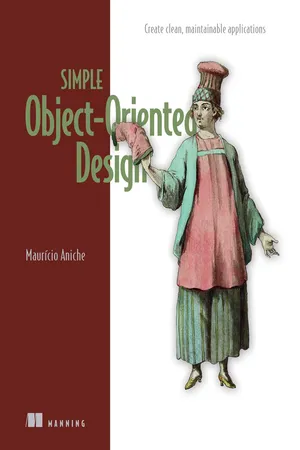
- 192 pages
- English
- ePUB (mobile friendly)
- Available on iOS & Android
About this book
Write object-oriented code that's manageable, maintainable, and future-proof. Keeping your object-oriented designs simple demands a creative approach—and that's exactly what you'll find in Simple Object-Oriented Design. This book is full of patterns and principles for reducing complexity, each one proven in author Mauricio Aniche's 20-year career in software development. You'll learn how to tackle code's natural growth in complexity, and adopt a "good enough" approach that means it's easy to refactor when requirements change. You'll discover insightful principles for:
- Making code readable and documented
- Improving consistency and encapsulation
- Managing dependencies
- Designing abstractions
- Handling infrastructure
- Effective modularization
Learn what constitutes both good and bad object-oriented software design, discover how to make better trade-offs in design decisions, and when to embrace complexity over simpler data structures. With this book as your vital reference, you'll be ready to write code that will last the test of time, without slowing feature delivery to a crawl. About the technology Even a simple object-oriented application can quickly become complex as it evolves. Each new class, method, or feature means more state and abstractions to manage, which in turn increases complexity, maintenance, and time spent detangling legacy code. It takes effort and skill to keep your codebase simple. This book shows you how. About the book Simple Object-Oriented Design: Create clean, maintainable applications presents practical design principles you can use to keep an object-oriented codebase simple as it grows and changes. Written as a collection of practical techniques you can apply in any OO language, it offers tips for concise code, managing dependencies and modules, and designing flexible abstractions. Illuminating figures, real-world examples, and insightful exercises make each principle stick. What's inside
- Writing simple, understandable classes
- Flexible abstractions to extend your designs
- Reducing the impact of coupling
About the reader Readers should be familiar with an object-oriented language like Java, C#, or Python. About the author Maurício Aniche is a software engineer with 20 years of experience. He's also an Assistant Professor in Software Engineering at Delft University of Technology, and the author of Effective Software Testing. Table of Contents 1 It's all about managing complexity
2 Making code small
3 Keeping objects consistent
4 Managing dependencies
5 Designing good abstractions
6 Handling external dependencies and infrastructure
7 Achieving modularization
8 Being pragmatic
Frequently asked questions
- Essential is ideal for learners and professionals who enjoy exploring a wide range of subjects. Access the Essential Library with 800,000+ trusted titles and best-sellers across business, personal growth, and the humanities. Includes unlimited reading time and Standard Read Aloud voice.
- Complete: Perfect for advanced learners and researchers needing full, unrestricted access. Unlock 1.4M+ books across hundreds of subjects, including academic and specialized titles. The Complete Plan also includes advanced features like Premium Read Aloud and Research Assistant.
Please note we cannot support devices running on iOS 13 and Android 7 or earlier. Learn more about using the app.
Information
Table of contents
- Simple Object-Oriented Design
- Copyright
- dedication
- contents
- front matter
- 1 It’s all about managing complexity
- 2 Making code small
- 3 Keeping objects consistent
- 4 Managing dependencies
- 5 Designing good abstractions
- 6 Handling external dependencies and infrastructure
- 7 Achieving modularization
- 8 Being pragmatic
- index